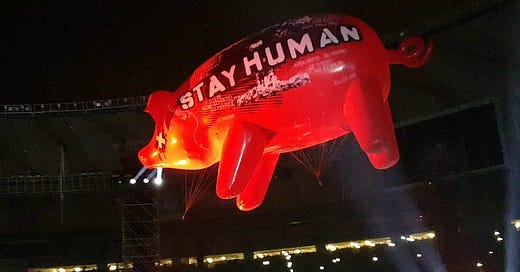How An Album Cover Became A Symbol Of Global Protest
Pink Floyd’s album cover of Animals created by Roger Waters has become an enduring symbol of rebellion
“I’ll start a revolution from my bed,” sang Noel Gallagher in the verses of the Oasis hit song ‘Don’t Look Back In Anger.’ But there will always be anger; & there will always be outrage — especially when the system is so severely unjust.
This story too began as so many cultural revolutions do, with an act of imagination envisioned perhaps from his own bed as Roger Waters, the sardonic soul of Pink Floyd, conceived a pig to serve as a symbol of protest. It was an inflatable, 40-foot-high pig balloon meant to hover ominously above London’s Battersea Power Station — a grim, monolithic temple of the decline of the Industrial Revolution.
This was 1977, the year of Animals, Pink Floyd’s snarling indictment of greed, authoritarianism, and societal decay, inspired by George Orwell’s Animal Farm. In Waters’ mind, the pig would symbolize power — bloated, unaccountable, and grotesquely out of place above a decaying symbol of progress gone awry.
But what was intended as a controlled act of rebellion & a rebuke of society & those in power, quickly slipped its leash. The pig, named “Algie,” broke free during the album cover’s photoshoot, soaring into Heathrow Airport’s airspace and grounding flights. “It was chaos,” recounts photographer Aubrey Powell, whose team frantically scrambled to retrieve the wayward flying pig after it decided to catch its own flight.
The incident made headlines, and suddenly, Algie wasn’t just a prop that was the brainchild of Waters but a symbol— a runaway metaphor for the lust for power & greed and the absurdity of trying to contain dissent & revolt.
The story of Animals begins in an era rife with social discontent. The album itself drew significant influence from George Orwell’s Animal Farm, which critiques class divisions, greed, and political decay. As Waters put it, the pig symbolized “some kind of out-of-control power,” a not-so-subtle jab at establishment hypocrisy.
The release of Animals coincided with a turbulent political climate in the UK at the time. It was a winter of discontent, a period marked by strikes, economic stagnation, and growing disillusionment with the government. The album, much like the flying pig itself, cut through the noise, acting as an unapologetic critique of societal ills & the power-mongering elite class.
Fast-forward to the present, and the image has aged like fine protest wine, or a Molotov cocktail in itself. Battersea Power Station has been converted into a luxury complex — an ironic twist for a symbol of decay and working-class struggle. Algie the pig, however, remains untamed in spirit much like his first flight.
The symbol of the giant flying pig has been resurrected & used globally in political demonstrations and pop culture, from anti-capitalist rallies & protests to Roger Waters’ own concerts, where it often sports slogans like “Stay Human” or “Resist.” Waters also morphed added imagery of Donald Trump alongside the flying pigs during his gigs at the time of Trump’s first term as POTUS (President Of The United States).
As the BBC note, the pig has evolved into a “universal symbol of protest,” transcending its original context to embody broader struggles against authoritarianism and inequality.
Why does this image still matter? Because, in an age where protest is increasingly digital, which often fades away with our shorter attention spans, the analog audacity of a 40-foot inflatable pig feels almost bizarre & quaint in equal bits — and yet, it works. It’s tactile, visceral, and unavoidably present.
As far as symbols go, it’s both absurd and profound & its surrealism mirrors the absurdity of the systems it critiques, making it a perfect icon for an era where reality often feels stranger than fiction or straight out of a burgeoning sci-fi film that we’re edging towards.
Looking ahead, the flying pig raises questions about the future of protest imagery & protests as well. Will tomorrow’s symbols be as enduring, or will they be fleeting memes lost & engulfed in endless doomscrolling ?— Popular for a moment & gone shortly after.
Algie’s longevity suggests that the most powerful symbols are those that root themselves in collective memory while adapting to new contexts. As Waters himself said, the pig is “a reminder that resistance is necessary.”
The pig's wings remind us that protest, at its best, is both a demand and a dream & the pursuit of a belief that things can, and should, be better; much better than it is at the moment & every decade that is to come.
This is about the future of humanity & not just some inconsequential phase in our history. This is what’s at stake. If anything, the pig reminds us that we must raise our voice against the injustices of far-right capitalism that’s gone unchecked & societal inequality & these are matters that are just the tip of the iceberg. Whether it’s the war machine or climate change, as long as power corrupts and pigs still seem capable of flying, Algie will keep soaring — both in the sky and in our hearts & minds.
Thank you for being a valuable subscriber to my newsletter Light Years!
If you liked this post & found it informative, feel free to share this publication with your network by clicking the button below…
I hope you found this post informative & it helped you in some way. As always, feel free to subscribe to my publication Light Years & support it & also share it if you’d like. Get it in your inbox by filling up the space below!
If you’d like to thank me for this post, if you found value in it, you can buy me a coffee instead of, or alongside subscribing to my publication, by scanning the QR code below so that I can sip my next brew of coffee, all thanks to you! :)






